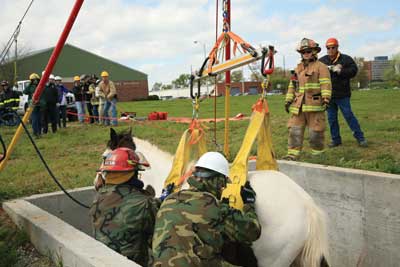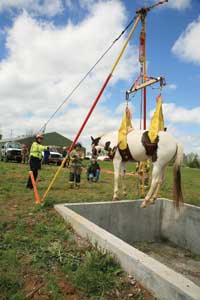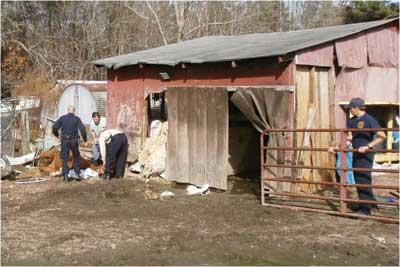By Chandra Davis
In January 2012, a call came into a Tennessee fire station for a trailer accident on Interstate 40. According to the Tennessee Department of Transportation, the commercial trailer was carrying 38 horses. By the end of the night, many of the horses were seriously injured, and three were dead. What happened? It was a large animal rescue (LAR) incident.
Some emergency responders may be reluctant to get involved with animals, saying their job is to protect people, not animals. Their job is also to protect property. If rescuing animals is not “part of the job description,” what about saving property? Horses are a multibillion-dollar industry in North America. Suddenly, equines take on new value!
 |
 |
| (1, 2) Photos courtesy of Eastern Kentucky University. |
But horses are not the only large animals you’ll see on your roads. Added to the growing number of horses are the other more common and less visible species that will be traveling through your area. Approximately 55 million animals are killed in the United States every day in slaughterhouses, and these animals are transported in tractor trailer rigs from factory farms to cities and towns all over North America. To put it in perspective, every week the equivalent of the population of the United States is transported to slaughter over city and country roads. And that doesn’t include the several species of animals traveling to shows, breeders, movie sites, and zoos. Did you know that three elephants recently rode from a Toronto, Canada, zoo to a sanctuary outside Sacramento, California? What if they had been involved in a road accident? How would you have handled it?
Most emergency responders in North America live and work in urban areas and have little contact with large animals, but even if you work in the downtown area of a large city, sooner or later you could get that dreaded call for a trailer rollover. If you are first to arrive on the scene and assume command, would you know what to do? Most rescue personnel don’t. How do you approach what could be a lethal situation for you, your crew, and the animals involved? You’re not trained for it, and it’s dangerous in ways you don’t understand.
WHAT IS LARGE ANIMAL RESCUE?
LAR is a method of safely and efficiently interacting with large animals in a rescue situation. This training prepares both emergency responders and veterinarians to rescue large animals without endangering human or animal lives or compromising public safety.
LAR has been designed to work within the incident command system (ICS). When a response involves multiple agencies, you will know the roles of each agency and how the agencies will interact. LAR covers scene safety and management, how to use the equipment already available on most fire apparatus, specialty equipment, and animal behavior.
According to experts, the most critical safety issue at the scene of a large animal incident is the responders’ lack of knowledge of and experience around large animals. At present, only about two percent of responders are trained in LAR. Responders must learn to read the animal’s body language to be safe in the field.
Once dispatched, a fire department or rescue unit must get confirmation that a large animal veterinarian has been called. A veterinarian is a must to assess the animal’s immediate needs in the field, but remember: Most vets are NOT trained in ICS or other rescue functions. As you work with multiple jurisdictions, you will want to keep your language as simple as possible so that everyone is “on the same page.” You can facilitate this by gathering a list of local vets for your dispatcher, and you may want to develop a memorandum of understanding (MOU) with the vets to decide the limits of their participation on-scene.
 |
| (3) Photo courtesy of the Campbell Rice-Carrolton (VA) Fire Department. |
Always consider your own safety first. Whether relating to an animal in distress or a human, if you are not safe, you cannot be effective in helping the victim. To be safe around a large animal, you need to understand its nature and limitations. When you look at it, you see its size, strength, and unpredictability. What you don’t see is its fragility. Legs, pelvises, and backs are easily broken, and that is often a death sentence for the animal. NEVER use the head, tail, or legs to move a down animal.
Because an animal’s first instinct is flight, it’s important to move slowly around it. Let it know where you are at all times. If a horse doesn’t hear you approach, a strange being in its safety space could cause it to panic. Any aggressive movement on your part could send the horse flying. A firefighter in turnouts is foreign and smells of blood, oil, and smoke.
As with any other incident, if YOU are not safe, you become part of the problem. Consider the following points at the scene of an animal incident.
- Your protocols probably don’t include loose large animals. Be aware of loose animals, even if they are not directly involved with the incident to which you are responding.
- Work quickly, but move slowly. Running toward an animal is an aggressive act.
- Turn off radios, equipment, and lights well before approaching the scene.
There are two rules in LAR. The first rule is, “There is always time to breathe.” In any situation, your first act should be to stop and take a breath. This allows you to ground yourself, not rush into a no-win situation. The second rule is, “You’re number one.” Always take care of yourself first. This sounds selfish on the surface, but if you’re not safe and you get into trouble, you become part of the problem and will be of no use to anyone.
Large animals “speak” with their bodies more than their voices. A first responder may not be able to read the animal’s “speaking.” Many large animals breathe through their nasal passages only and not their mouths, like humans. If you cover the nose area, you can suffocate the animal very quickly. Horses also respond negatively to the color yellow, as it is very intense for their eyes.
Do not stand directly behind a large animal or right in front. You are in the Danger Zone and can be injured. If the animal’s feet are facing you, you risk being injured. Pay attention to the animal’s ears. If the ears are forward, the animal is listening; if they are strait back and flat, the animal is likely to attempt to injure you. A horse or other large animal species can injure a human with lightning fast speed.
Rescue situations
Have the veterinarian check the condition of the horse and administer a sedative, if necessary. If the horse is injured and trapped in the overturned trailer, it will need sedation.
Don’t sedate the horse before the vet arrives. That will make the vet’s job that much harder for the following reasons.ul>
If the trailer is on its side, do NOT open the back door and look inside. The animal will attempt to escape and wind up doing more harm to itself. Only about one percent of rescuers have any knowledge of how to safely remove a horse from a rollover.
These are some examples of what a firefighter may encounter in a LAR. It never hurts to reach out to horse groups in your area. Remember, it can be a great learning experience and partnership.
CHANDRA DAVIS is a firefighter/public education officer for the Hornbeak (TN) Volunteer Fire Department and has been an active member of the fire department for 13 years. She is a member of the NFPA Technical Advisory committee 150 Animal Housing Units and NFPA section member for the Fire Service and Education. She is certified in advanced large animal rescue and is a former zoological keeper.
Chandra Davis will present “Introduction to Large Animal Rescue” on Wednesday, April 9, 10:30 a.m.-12:15 p.m., at FDIC 2014 In Indianapolis.
Fire Engineering Archives

